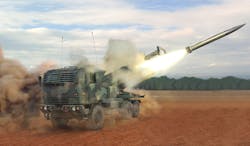Lockheed Martin to upgrade weapons payloads and navigation and guidance on ATACMS battlefield munitions
REDSTONE ARSENAL, Ala. – U.S. Army fire-support experts are asking Lockheed Martin Corp. to convert ground-launched munitions with single explosive charges to versions with airburst mode and area effects capability by adding proximity fuses.
Officials of the Army Contracting Command at Redstone Arsenal, Ala., announced a $98.1 million order Thursday to the Lockheed Martin Missiles and Fire Control segment in Grand Prairie, Texas, for the Army Tactical Missile Systems Guided Missile (ATACMS) and Launching Assembly Service Life Extension (SLEP) program.
The Lockheed Martin ATACMS is a surface-to-surface missile with a top range of about 100 miles. It can fire from multiple rocket launchers, including the M270 Multiple Launch Rocket System (MLRS), and M142 High Mobility Artillery Rocket System (HIMARS).
The ATACMS SLEP project seeks to convert M39/M39A1 ATACMS rockets, which have anti-personnel and anti-materiel (APAM) bomblet payloads. The job is to convert the M57 ATACMS single-explosive rocket using the same single warhead used in the Navy’s Harpoon missile.
Moreover, the ATACMS SLEP project seeks to provide the upgraded ATACMS munition with a proximity fuse to provide the blast effects, anti-personnel capability, and the ability to destroy or damage soft targets over large areas. The new missile is designated M57E1 ATACMS Unitary.
Other aspects of ATACMS SLEP involve re-graining the M39/M39A1 motor, updating obsolete navigation and guidance software and hardware, and replacing the M39/M39A1 APAM bomblets with the WDU-18/B warhead that is used in the Navy’s Harpoon anti-ship missile.
Army leaders say the warhead change will meet the unexploded ordnance rate requirement defined in the 2008 Pentagon Policy on Cluster Munitions and Unintended Harm to Civilians.
The ATACMS SLEP missile uses inertial measurement unit and GPS guidance to attack point and area targets out to a range of about 186 miles. It will engage long-range point or area-located targets including air defense, command posts, assembly areas, and high-value targets without the hazard of unexploded submunitions.
On this order Lockheed Martin will do the work in St. Louis; Lufkin, Texas; Willison, Vt.; Boulder, Colo.; Camden, Ariz; Grand Prairie, Texas; Clearwater, Fla.; and Windsor Locks, Conn., and should be finished by 30 Sept. 2024.
For more information contact Lockheed Martin Missiles and Fire Control online at www.lockheedmartin.com, or the Army Contracting Command-Redstone at https://acc.army.mil/contractingcenters/acc-rsa/.

John Keller | Editor-in-Chief
John Keller is the Editor-in-Chief, Military & Aerospace Electronics Magazine--provides extensive coverage and analysis of enabling electronics and optoelectronic technologies in military, space and commercial aviation applications. John has been a member of the Military & Aerospace Electronics staff since 1989 and chief editor since 1995.

